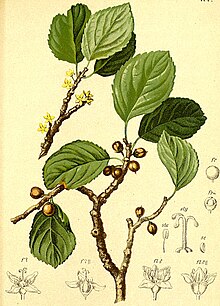Rhamnaceae
| Buckthorn family | |
|---|---|
 |
|
| Rhamnus pumila Turra | |
| Scientific classification | |
| Kingdom: | Plantae |
| (unranked): | Angiosperms |
| (unranked): | Eudicots |
| (unranked): | Rosids |
| Order: | Rosales |
| Family: |
Rhamnaceae Juss. |
| Type genus | |
|
Rhamnus L. |
|
| Genera | |
|
See text. |
|
 |
|
| The range of Rhamnaceae. | |
| Synonyms | |
|
Frangulaceae DC. |
|
See text.
Frangulaceae DC.
Phylicaceae J.Agardh
Ziziphaceae Adans. ex Post & Kuntze
The Rhamnaceae are a large family of flowering plants, mostly trees, shrubs, and some vines, commonly called the buckthorn family.
The family contains about 55 genera and 950 species. The Rhamnaceae have a worldwide distribution, but are more common in the subtropical and tropical regions. The earliest fossil evidence of Rhamnaceae is from the Eocene.
Leaves of Rhamnaceae family members are simple, i.e., the leaf blades are not divided into smaller leaflets. Leaves can be either alternate and spiraling, or opposite. Stipules are present. These leaves are modified into spines in many genera, in some (e.g. Paliurus spina-christi and Colletia cruciata) spectacularly so. Colletia stands out by having two axillary buds instead of one, one developing into a thorn, the other one into a shoot.
The flowers are radially symmetrical. There are 5 (sometimes 4) separate sepals and 5 (sometimes 4 or none) separate petals. The petals may be white, yellowish, greenish, pink or blue, and are small and inconspicuous in most genera, though in some (e.g. Ceanothus) the dense clusters of flowers are conspicuous. The 5 or 4 stamens are opposite the petals. The ovary is superior, with 2 or 3 ovules (or one by abortion).
The fruits are mostly berries, fleshy drupes, or nuts. Some are adapted to wind carriage, but most are dispersed by mammals and birds. Chinese jujube is the fruit of the jujube tree (Ziziphus zizyphus) and is a major fruit in China.
The American genus Ceanothus, which has several showy ornamental species, has nitrogen-fixing root nodules.
...
Wikipedia
